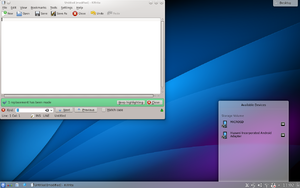 | |
 KDE Plasma Desktop 4.10 | |
| Developer(s) | KDE |
|---|---|
| Initial release | 11 January 2008[1] |
| Final release | 4.14.38 (November 7, 2017) [±][2] |
| Written in | C++ (Qt 4) |
| Operating system | Whole desktop: Unix-like with X11 and also Windows XP–7.[3] Applications only: Mac OS X v10.4–10.6 |
| Available in | Multilingual[4] |
| Type | Desktop environment |
| License | GPL, LGPL, BSD license, MIT license and X11 license[5] |
| Website | kde |
KDE Software Compilation 4 (KDE SC 4) was the only series of the so-called KDE Software Compilation (short: KDE SC), first released in January 2008 and the last release being 4.14.3 released in November 2014.[1][6] It was the follow-up to K Desktop Environment 3. Following KDE SC 4, the compilation was broken up into basic framework libraries, desktop environment and applications, which are termed KDE Frameworks 5, KDE Plasma 5 and KDE Applications, respectively.
Major releases (4.x) were released every six months, while minor bugfix releases (4.x.y) were released monthly.[7]
The series included updates to several of the KDE Platform's core components, notably a port to Qt 4. It contained a new multimedia API, called Phonon, a device integration framework called Solid and a new style guide and default icon set called Oxygen. It also included a new, unified desktop and panel user interface called Plasma, which supported desktop widgets, replacing K Desktop Environment 3's separate components.
One of the overall goals of KDE Platform 4 was to make it easy for KDE applications to be portable to different operating systems. This was made possible by the port to Qt 4, which facilitated support for non-X11-based platforms, including Microsoft Windows and Mac OS X. Versions 4.0 to 4.3 of KDE Software Compilation were known simply as KDE 4 – the name change was a component of the KDE project's re-branding to reflect KDE's increased scope.
- ^ a b "KDE 4.0 Release Announcement". 11 January 2008.
- ^ "KDE Ships KDE Applications and Platform 4.14.3". KDE. 11 November 2014. Retrieved 13 November 2015.
- ^ "Replace Windows Shell with KDE Plasma Desktop".
- ^ "KDE Localization statistics".
- ^ "Policies/Licensing Policy". kde.org.
- ^ "KDE Ships Applications and Platform 4.14.3". KDE. 11 November 2014. Retrieved 19 March 2018.
- ^ "KDE 4.1 - release team aims at July 2008". 18 January 2008.